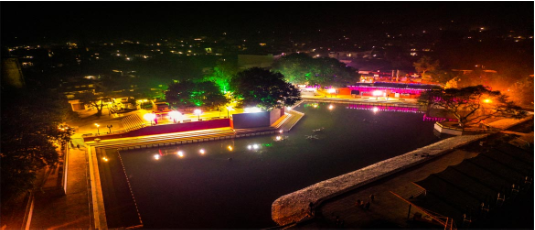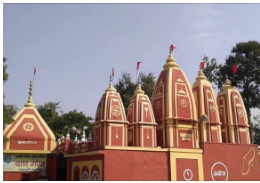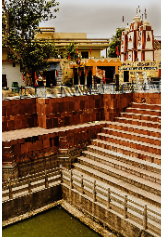Introduction to Mahabharata
- The north Indian state of Haryana is dotted with mystical stories and folklores.it has been a silent witness to several great events like Mahabharata.
close-up of a statue depicting Krishna’s hand holding Sudarshan chakra;(mahabharata)
- The land is named after King Kuru of the Bharata dynasty who was the ancestor of Kauravas and Pandavas. The early name of the city was Thaneswar or Sthaneswar which is a Sanskrit term that literally translates to the place of gods.
- There is evidence of the existence of Kurukshetra in ancient times. The city is mentioned in Vamana Purana. There have been excavations that concluded that the city existed before the Harappan civilization. Few ancient records state that the city was a great center of learning and Vedic civilizations.
- It is believed that Kurukshetra is the place where learned rishis compiled Rigveda and it is also the place where Manusmriti was penned.
- The tanks of Kurukshetra are mentioned in Akbarnama and described by Francois Bernier, a French traveler who visited the city in Shah Jahan’s reign. The Chinese traveler Hiuen Tsang visited the city and there are stories narrating how emperor Ashoka transformed it into a learning center.
- As per Vamana Purana, the city was selected by King kuru for incorporating the eight virtues – brahmacharya, yajna, charity, purity, kindness, forgiveness, truth, and austerity. Impressed by the same, Lord Vishnu blessed him and since then it is believed that those who die there, go to heaven.
- The land is also called the holy land as it envelops many temples in its holy folds. The sprawling city is thus dotted with temples, pilgrimages, and sacred tanks.
Brahma Sarovar: the point of creation of the universe-
close-up of Brahma Sarovar;
- The tank is dedicated to lord shiva and it is believed that Lord Brahma created the universe on this piece of land. The tank witnesses several migratory birds in the winters while it features deep daan and aarti on Geeta Jayanti. The scenic Sarovar surrounds the Sarveshwar Mahadev temple.
- It is believed that Lord Brahma worshipped Shiva at this spot and during the Mahabharata war, this temple was destroyed every day and miraculously reconstructed at night.
Jyoti sar: the place where Bhagavad Geeta was narrated for the first time-
light and sound show at Jyotisar(mahabharata)
- Jyotisar is the place where Bhagavad Geeta was first narrated by Lord Krishna under a banyan tree. It is believed that Adi Shankaracharya had identified the place during his journey to the Himalayas. Later a temple was built by the king of Kashmir followed by a stone slab by the king of Darbhanga.
- Later, an east-facing chariot showing Geeta updesha was installed on the platform. A light and sound show is performed every evening based on the teachings of Bhagavad Geeta.
Bhisma Kund: a stepwell dedicated to Bhisma pitamah –
close-up of Bhishma Kund temple(mahabharata)
close-up of the stepwell(mahabharata)
Bhisma Kund is the place where Bhishma pitamah rested on a bed of arrows before death. It is believed that it is the point where Arjuna pierced an arrow into the earth to quench the thirst of his grandfather. The place thus owns the name – Banganga.
Raja Karn ka qila:
The fort was first surveyed by Alexander Cunningham in 1920. Later the site was excavated by the archaeological survey of India. It has been found that the fort holds evidence of three different cultural periods in Indian history.
close-up of Raja Karn ka qila
Painted grey ware (4th century B.C – 1st century B.C), Red polished ware ( 1st century B.C -3rd century B.C) along with stamped pottery, terracotta objects, and seals with Brahmi script have been found. The entire fortification looks like a medieval era setup.
Raja Harsha ka Tila:
The Harsha mounds have the remains of an ancient city. Excavations have found potsherds of painted gray ware from the lowest layer indicating the existence of a settlement since the Christin era. Apart from this, several antiquities have been found that belong to six different cultures.
close-up of Raja Harsha ka Tila
Remains of Rajputs, Guptas, Kushans, and Bardhaman have been found. The relics of the Indo- Islamic period along with a garden complex are housed within the mound.
Vishvamitra ka Tila: remains of ancient Vishnu temple
The mound is archaeologically significant as two inscriptions from the Gurjar pratihara period have been found here. 
close-up of vishvamitra ka Tila
One inscription mentions the details of three Vishnu temples in the town, while the other mentions the system of tax collection in the temples. Intricate stone sculptures from the times of Mahabharata and an ancient temple plinth made of baked bricks have been excavated from the site.
Temples and other architectures in the holy folds:
night view of Sthaneshwar Mahadev temple
The city is enveloped by temples like Sthaneshwar Mahadev temple, Bhadrakali temple, Kartikeya temple, Prachin shiva temple, and Pashupatinath temple.
close-up of Sheikh Chilli’s tomb
Apart from the Hindu temples, the city houses Mughal architecture like the Kos Minar and sheik Chilli’s tomb thereby depicting religious harmony.[mahabharata]
 close-up of a phulkari style dupatta
close-up of a phulkari style dupatta
- Other attractions in the city include Kalpana Chawla memorial planetarium, Thanesar archaeological site museum, 48 Kosa parikrama, Shri Krishna museum, and Kurukshetra panorama and science center.
- The city is famous for handloom and pottery. Phulkari style of weaving is quite famous in the city while one can relish flatbreads,meethe chawal, kheer, lassi, and kadhi pakora on the streets.[mahabharata]
internal links:
Most visited place ‘City of Taj’ Agra. you should visit also – Erakina
All tourister’s Choice Loco Shed(Rewari Museum)-Arakina
A charming place for visitors to visit Bedni “Bugyal hill station”- Erakina












